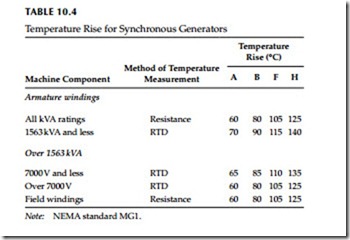AC Generators
Application criteria for AC generators are discussed next.
Service Conditions
Ac generators, like AC motors, should be correctly selected with respect to their service conditions. The usual and unusual conditions are the same for genera- tor applications as those listed for AC motors. Some generators may operate in accordance with their ratings under one or more unusual service conditions. However, where some unusual service condition exists, a special-purpose generator may be required. Even though in such cases past experience may be the best guide in selecting the machine, it is recommended that the manufacturer be consulted concerning the mechanical and thermal duty of the machine.
Ratings
The continuous basis of rating synchronous generators is in kilowatts (kW) or kilovolt-amperes (kVA) at 80% PF. The ratings of kVA, speed, voltage, frequency, and so on, are expressed in NEMA MG1 standards for three-phase and single-phase machines. The excitation voltages for the field windings are also stated in the same NEMA standards; they are 62.5, 125, 375, and 500 V DC. These excitation voltages apply to machines with brushes only. Synchronous generators are capable of carrying a 1 min overload of 50% of normal rated current with the field set at normal rated load excitation. A synchronous generator is designed to withstand three-phase short-circuit cur- rent at its terminal for 30 s operating at rated kVA and PF, at 5% overvoltage with fixed excitation. The phase current due to faults other than three-phase faults must be limited by external means to a value that does not exceed the maximum phase currents obtained from three-phase fault.
The kW output of the machine depends upon the voltage, armature cur- rent, and PF. Also, the synchronous generator kVA ratings may be stated at definite voltage and frequency. The permissible load output of the synchronous generator depends upon the balance of the load. It is maximum for balanced loads and minimum for single-phase loads.
Temperature Rise
The temperature rise under rated load conditions for synchronous generators is based on the insulation system used for the machines. The temperature rise is determined in accordance with the latest IEEE std 115-1995, IEEE guide: Test Procedures for Synchronous Machines. The method of temperature determination may be resistance or embedded resistance temperature detector (RTD). Table 10.4 lists the various temperature rises for the various generator sizes and insulation systems.
The standard ambient temperature is taken as 40°C, and where the ambient temperature is higher than the standard, it is recommended that the temperature rise of generators be reduced as follows:
• For increases in ambient temperature above 40°C up to and including 50°C, decrease the temperature rise by 10°C
• For increases in ambient temperature above 50°C up to and including 60°C, decrease the temperature rise by 20°C
Variation in Voltage
Synchronous generators can operate at rated kVA, frequency, and PF at voltages above and below the rated voltage not to exceed 5%. The maximum voltage any synchronous generator can produce at a definite frequency depends upon the permissible pole flux and field heating. To maintain a rated voltage output, specific field excitation is necessary at some specified load and PF.
Regulation
Regulation of a synchronous generator at any given PF is defined as a percentage rise in voltage, a constant frequency at excitation, when rated kVA load is removed. The regulation depends upon armature reactance, armature effective resistance, change in leakage flux with change in load, and armature reaction.
